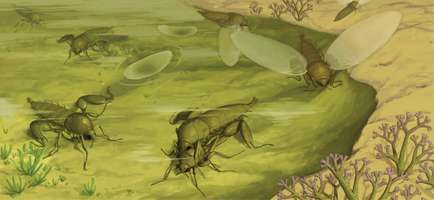February 21, 2013 report
Researchers find Jurassic strashilids not a parasite after all

(Phys.org)—A research team made up of members from China, the U.S. and France has found new evidence that overturns the notion that a species of ancient insects known as strashilids were parasites. Instead, as the team writes in their paper published in the journal Nature, it appears they were actually amphibious flies that lost their ability to eat as they grew into adulthood.
A limited number of specimens led researchers to conclude that strashilids were parasites—they had mouths that resembled blood suckers and legs of the type that are used for hooking onto bird wings. Recently, however, the team obtained 13 more specimens (all from approximately 165 million years ago) from what is now Inner Mongolia, and made several discoveries as a result, which they say, proves the strashilids were not parasites at all.
First of all, only the male of the species had the type of legs that could be used to hook onto bird feathers—they apparently actually used them to hook onto females during mating. Second of all, it appears the mouths that were thought to be of the kind used for sucking blood, didn't work at all as the insects grew to become adults. Also, several of the more recently found specimens had wings, which indicated that at least for part of their life cycle, strashilids didn't require a host to move from place to place. The researchers also noted that the males retained larval abdominal respiratory gills which may have helped them survive in the water during their final stage of life—both genders shed their wings and crawled into the water to mate—two wingless pairs were found doing just that. Finally, the team found in analyzing the sex organs of strashilids that they resembled those of modern water flies called Nymphomyiidae, which have feathery wings and live near fast moving water.

Taken together, the new evidence suggests that strashilids were very much like modern water flies that start out life in the water, grow wings during adulthood, then shed them and return to the water to reproduce and then die. Thus, they could not have been parasites, the team concludes.
More information: Amphibious flies and paedomorphism in the Jurassic period, Nature (2013) doi:10.1038/nature11898
Abstract
The species of the Strashilidae (strashilids) have been the most perplexing of fossil insects from the Jurassic period of Russia and China. They have been widely considered to be ectoparasites of pterosaurs or feathered dinosaurs, based on the putative presence of piercing and sucking mouthparts and hind tibio-basitarsal pincers purportedly used to fix onto the host's hairs or feathers. Both the supposed host and parasite occur in the Daohugou beds from the Middle Jurassic epoch of China (approximately 165 million years ago). Here we analyse the morphology of strashilids from the Daohugou beds, and reach markedly different conclusions; namely that strashilids are highly specialized flies (Diptera) bearing large membranous wings, with substantial sexual dimorphism of the hind legs and abdominal extensions. The idea that they belong to an extinct order is unsupported, and the lineage can be placed within the true flies. In terms of major morphological and inferred behavioural features, strashilids resemble the recent (extant) and relict members of the aquatic fly family Nymphomyiidae. Their ontogeny are distinguished by the persistence in adult males of larval abdominal respiratory gills, representing a unique case of paedomorphism among endopterygote insects. Adult strashilids were probably aquatic or amphibious, shedding their wings after emergence and mating in the water.
Journal information: Nature
© 2013 Phys.org




















